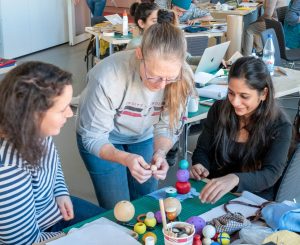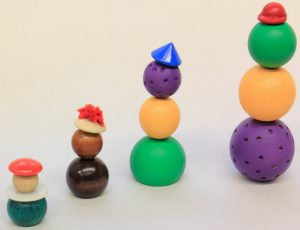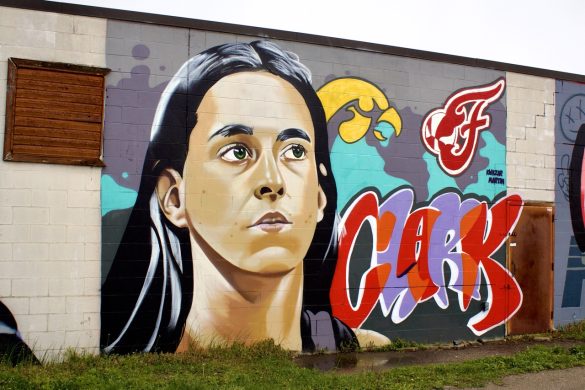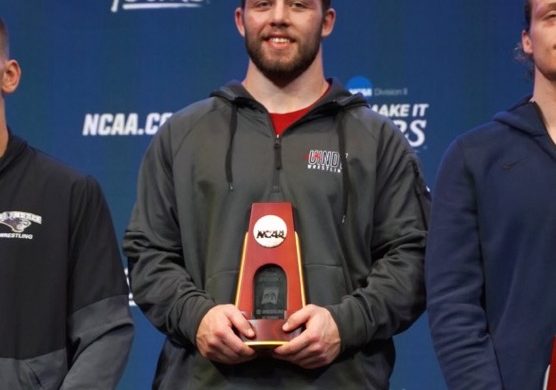The 18th International Creativity Workshop “Toy Design and Inclusive Play” hosted by the Berlin-based, non-profit association “Fördern durch Spielmittel e.V.” (“Support and Challenge through Toys“) was held from Jan. 14-28. The 23 participants included designers, toy developers, artists, teachers, psychologists and therapists from around the world, including the only participant from the United States, University of Indianapolis Professor of Teacher Education Greta Pennell. According to the program’s application, the aim was to “develop new toys for children adults that increase their joy of playing, support inclusive education and contribute to ecological sustainability.”
Greta Pennell (left) and Surabhi Khanna (right) construct Pennell’s toy during her sabbatical trip to Germany.
The two-week workshop began with the participants explaining their previous work, getting 10 minutes each to present. Pennell talked about her First Year Seminar course, Gender in Toyland, where students learn about how children are socialized to understand gender roles through toys and toy advertisements.
After this, they were broken up into interdisciplinary teams of four or five and assigned one of four mentors. For her mentoring, Pennell worked with Surabhi Khanna, who is from India. She said when she first joined the International Toy Research Association, of which she is now Vice President, she met Khanna’s father so she was excited to work with Khanna. The teams broke up and visited different institutions around Berlin to get varying ideas to go toward designing a new inclusive toy.
“So everywhere that people went—they went to places where there were people with disabilities,” Pennell said. “The idea was to really use this notion of a universal design for learning or universal design in general, like how do we design to include everybody. And then we came back, shared our observations from what we had seen at our respective sites.”
While some participants went to senior care facilities or schools specifically for children on the autism spectrum, others went to regular schools that had children with special needs mainstreamed in, which Pennell said is more common in Germany. This experience was supposed to inspire the participants own toy design.
Pennell said she did not realize that she would be designing a toy when she started the workshop and had no prior experience as she is a developmental psychologist that teaches about gender and toys. Khanna had Pennell begin by sketching her idea, and Pennell said she wanted to design an invitational toy but that there was some confusion on what that meant.
“In explaining it, that’s when I kind of had my aha moment because I showed her [Khanna] what I meant,” Pennell said. “What I did is an old trick that I had done when I used to be at the Children’s Museum to teach kids about Newton’s laws of motion and inertia. And I’m sure you’ve seen it where the magician has the tablecloth, the table setting and rips tablecloth out from underneath. Well, I just did it on a really small scale.”
Pennell’s toy is called “Don’t Lose Your Head” and featured four stacks of small balls of varying heights and colors and a variety of fabric. The objective of the toy is put the fabric under the stacks of balls and then pull it out without knocking over the stack. The balls have a small hole drilled in the top and a tiny dowel rod out of the bottom to help hold them together, however, the stacks still wobble, which adds a level of difficulty. The stacks also have little hats on top and as they get taller they become more wobbly. The fabric ranges in difficulty due to thickness and type, with the easiest being a rainbow organza and the most difficult being suede leather. Each of the fabrics also has different edges to add another element.
Featuring stacked balls and different fabrics with varying edges, Pennell’s toy has multiple levels of difficulty.
“So that if you really wanted to use it as a science teaching tool, there was a way then you could ask kids, ‘So does it matter? Does the color of the fabric matter? Does the texture of the fabric matter? Does the shape of the edge matter?’” Pennell said. “And they could test that out so that you can use it with older kids in a more sophisticated way.”
Participants presented their prototypes to each other to get feedback and then decided which to fully develop. Pennell said they worked from about 9 a.m. to 11 p.m. with time for lunch and dinner. On the final day of the workshop, an exhibition was held to showcase the results of the workshop. About 300 people came to the exhibition, including the mayor of Berlin who gave remarks and judges, according to Pennell.
Pennell said she has many ideas that she could bring back to UIndy, and learned a lot about other countries and how they do toy design. For example, she said in India one of the schools of engineering has a toy design research department, which she thought could be interesting to implement.
“One thing that I’m really interested in is how we might use what I’ve learned about toy design…” Pennell said. “In terms of the courses that I do teach, thinking about what did I learn about collaborative teams, design process thinking, how could I incorporate that into my courses.”
Through this experience Pennell met many different people from all over the world. She said, if the timing works out, she would love to Skype them into her classes so that they can share their expertise with her students.
“I think the best part of it was forming these collegial relationships,” Pennell said. “It’s amazing how close we all became in just two weeks and the depth of the discussions that we could have about what are our challenges that we’re facing in our home countries.”










